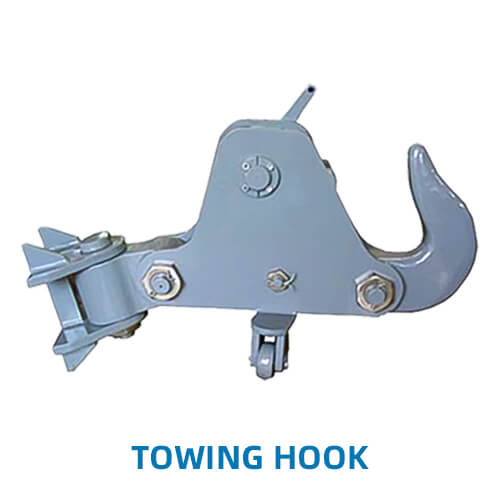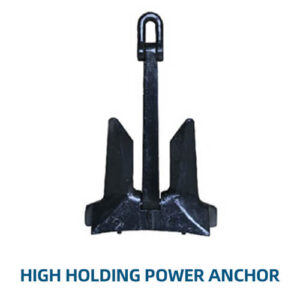Key Features of a Towing Hook:
- Design and Construction:
- Material: Towing hooks are typically made from high-strength, corrosion-resistant materials such as forged steel or stainless steel. These materials are chosen for their durability and ability to withstand the significant forces involved in towing operations.
- Shape and Structure: The towing hook usually has a curved or hook-shaped design that allows it to secure a towing line or chain. It may include features such as a latch or safety pin to ensure that the hook remains closed and secure during use.
- Load Capacity: Towing hooks are designed to handle specific load capacities, which should be clearly marked and matched to the requirements of the towing operation.
- Types of Towing Hooks:
- Standard Towing Hooks: Basic hooks designed for general towing applications. They often include a simple latch or safety pin to secure the connection.
- Rotating Towing Hooks: Features a rotating mechanism that allows the hook to align with the direction of the load, reducing stress on the hook and the connected equipment.
- Quick-Release Towing Hooks: Equipped with a mechanism that allows for rapid attachment and detachment, useful in situations where quick connections are required.
- Heavy-Duty Towing Hooks: Designed for high-capacity towing applications, such as those involving large vessels or heavy equipment. These hooks are built to handle extreme loads and stresses.
- Applications:
- Marine Towing: In marine operations, towing hooks are used to connect tugboats to barges, ships, or other vessels for towing purposes. They provide a secure and reliable connection that can handle the forces of the sea.
- Vehicle Recovery: Towing hooks are commonly used in vehicle recovery operations to connect tow trucks or recovery vehicles to disabled vehicles. They enable the safe and effective movement of vehicles in distress.
- Heavy Lifting: In industrial settings, towing hooks are used to connect lifting equipment to heavy loads, such as construction materials or machinery, for movement and positioning.
- Offshore Operations: Towing hooks are used in offshore operations to connect tow lines to floating structures, supply vessels, or drilling rigs.
- Performance Characteristics:
- Strength and Durability: Towing hooks are designed to handle high loads and resist wear and corrosion. Their strength is critical to ensuring a safe and reliable towing operation.
- Ease of Use: The design of the towing hook should allow for easy attachment and detachment of the towing line or chain, facilitating efficient operation.
- Safety Features: Many towing hooks include safety features such as latches or pins to prevent accidental release and ensure secure connections.
- Maintenance and Care:
- Regular Inspection: Inspect towing hooks regularly for signs of wear, corrosion, or damage. Look for any cracks, deformation, or issues with the latch or safety pin.
- Cleaning: Keep towing hooks clean and free from debris, salt, and rust. Regular cleaning helps prevent corrosion and maintains the hook’s functionality.
- Lubrication: Lubricate moving parts, such as the latch or rotating mechanism, to ensure smooth operation and prevent wear.
- Safety Considerations:
- Load Limits: Always adhere to the maximum load capacity of the towing hook. Overloading can lead to failure and potential accidents.
- Proper Use: Use the towing hook according to the manufacturer’s instructions and ensure it is correctly attached to avoid accidents and equipment damage.
- Training: Ensure that personnel involved in towing operations are properly trained in the use and maintenance of towing hooks to ensure safe and effective operation.
Advantages of Using a Towing Hook:
- Secure Connection: Towing hooks provide a strong and reliable connection between the towing equipment and the load, ensuring safe towing operations.
- Versatility: Suitable for a wide range of applications, including marine, automotive, and industrial towing.
- Durability: Designed to withstand heavy loads and harsh environments, making them a durable choice for demanding operations.
Considerations for Towing Hooks:
- Compatibility: Ensure that the towing hook is compatible with the towing line or chain and the equipment being towed. Proper sizing and load ratings are essential for safe operation.
- Cost: High-quality towing hooks may be more expensive, but their durability and performance often justify the investment.
Towing hooks are critical components in many towing and lifting operations, providing a reliable means of connecting towing lines or chains to equipment. Their strength, durability, and ease of use make them essential tools in marine, automotive, and industrial applications, ensuring safe and effective handling of heavy loads and challenging towing tasks.






